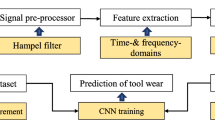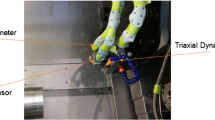Abstract
Insufficient data is always a challenge for developing an accurate machine learning or deep learning model in manufacturing processes, especially in tool wear monitoring under varied cutting conditions. This paper presents a Random Forest model for predicting tool wear under varied cutting conditions as well as studies extracted signal features. The Random Forest algorithm was chosen as the machine learning model, rather than the novel deep learning model. This was due to the feature importance investigation, which was embedded in the Random Forest algorithm, thereby making it easier to study the physical meanings of signal features. The frequency domain signals were rearranged as features related to spindle speeds and machine tool structure based on domain knowledge. This is the first paper to rearrange the frequency domain signals for observing the physical meanings of selected features. When data normalization was adopted, frequency domain signals related to spindle speeds were excluded from important features. Only spectrum energy related to structure vibration and time domain signals were important features. Data normalization enhanced the weighting of structure vibration features in a machine learning model. This study showed that feature normalization made the machine learning model more adaptable to different cutting conditions. Furthermore, prediction accuracy for cutting condition of spindle speed = 42,000 rpm and feed = 1.5 μm/rev (lowest prediction accuracy among cutting tests in this study) showed an increase from 68.0 to 84.1%. In addition, spindle speed had a more significant effect than feed on classification accuracy in tool wear monitoring based on experimental results. As a result, at least two data sets of the same spindle speed as in tool wear prediction were recommended to be used for model training. When there were at least two data sets in training data with the same spindle speed as in testing data, the study showed prediction accuracies were greater than 75% without data normalization and 81% with data normalization.



















Similar content being viewed by others
Abbreviations
- \({\mathrm{X}}_{i}^{j}\) :
-
Normalized value of the jth feature in Eq. (1)
- \({x}_{i}^{j}\) :
-
Original sample value of the jth feature in Eq. (1)
- \({\mu }^{j}\) :
-
Mean value of the jth feature in Eq. (1)
- \({\sigma }^{j}\) :
-
Standard deviation of the jth feature in Eq. (1)
- 0 (label 0):
-
Index for initial tool wear (0–20 μm) in Figs. 5–9 and Fig. 11
- 1 (label 1):
-
Index for normal tool wear (20–80 μm) in Figs. 5–9 and Fig. 11
- 2 (label 2):
-
Index for serious tool wear (> 80 μm) in Figs. 5–9 and Fig. 11
References
Ntemi M, Paraschos S, Karakostas A, Gialampoukidis I, Vrochidis S, Kompatsiaris I (2022) Infrastructure monitoring and quality diagnosis in CNC machining: a review. CIRP J Manuf Sci Technol 38:631–649. https://doi.org/10.1016/j.cirpj.2022.06.001
Lin W-J, Chen J-W, Jhuang J-P, Tsai M-S, Hung C-L, Li K-M, Young H-T (2021) Integrating object detection and image segmentation for detecting the tool wear area on stitched image. Sci Rep 11(1):19938. https://doi.org/10.1038/s41598-021-97610-y
Malekian M, Park SS, Jun MBG (2009) Tool wear monitoring of micro-milling operations. J Mater Process Technol 209(10):4903–4914. https://doi.org/10.1016/j.jmatprotec.2009.01.013
Tamura S, Sekigawa K, Matsumura T (2021) Monitoring of tool wear distribution with cutting force measurement in drilling. J Adv Mech Des Syst Manuf 15(4):JAMDSM0047. https://doi.org/10.1299/jamdsm.2021jamdsm0047
Uekita M, Takaya Y (2017) Tool condition monitoring for form milling of large parts by combining spindle motor current and acoustic emission signals. Int J Adv Manuf Technol 89(1):65–75. https://doi.org/10.1007/s00170-016-9082-6
Niaki FA, Ulutan D, Mears L (2015) In-process tool flank wear estimation in machining gamma-prime strengthened alloys using Kalman filter. Procedia Manuf 1:696–707. https://doi.org/10.1016/j.promfg.2015.09.018
Wu D, Jennings C, Terpenny J, Gao RX, Kumara S (2017) A comparative study on machine learning algorithms for smart manufacturing: tool wear prediction using random forests. ASME J Manuf Sci Eng 139(7):071018. https://doi.org/10.1115/1.4036350
Huang Z, Zhu J, Lei J, Li X, Tian F (2020) Tool wear predicting based on multi-domain feature fusion by deep convolutional neural network in milling operations. J Intell Manuf 31(4):953–966. https://doi.org/10.1007/s10845-019-01488-7
Dimla SDE (2002) The correlation of vibration signal features to cutting tool wear in a metal turning operation. Int J Adv Manuf Technol 19(10):705–713. https://doi.org/10.1007/s001700200080
Lu M-C, Wan B-S (2013) Study of high-frequency sound signals for tool wear monitoring in micromilling. Int J Adv Manuf Technol 66(9):1785–1792. https://doi.org/10.1007/s00170-012-4458-8
Kothuru A, Nooka SP, Liu R (2018) Application of audible sound signals for tool wear monitoring using machine learning techniques in end milling. Int J Adv Manuf Technol 95(9):3797–3808. https://doi.org/10.1007/s00170-017-1460-1
Wan B-S, Lu M-C, Chiou S-J (2022) Analysis of spindle AE signals and development of AE-based tool wear monitoring system in micro-milling. J Manuf Mater Process 6(2):42. https://doi.org/10.3390/jmmp6020042
Ferrando Chacón JL, Fernández de Barrena T, García A, Sáez de Buruaga M, Badiola X, Vicente J (2021) A novel machine learning-based methodology for tool wear prediction using acoustic emission signals. Sens 21(17):5984. https://doi.org/10.3390/s21175984
Li X, Liu X, Yue C, Liang SY, Wang L (2022) Systematic review on tool breakage monitoring techniques in machining operations. Int J Mach Tools Manuf 176:103882. https://doi.org/10.1016/j.ijmachtools.2022.103882
Huang Y, Liang SY (2004) Modeling of CBN tool flank wear progression in finish hard turning. ASME J Manuf Sci Eng 126(1):98–106. https://doi.org/10.1115/1.1644543
Akhavan Niaki F, Michel M, Mears L (2016) State of health monitoring in machining: extended Kalman filter for tool wear assessment in turning of IN718 hard-to-machine alloy. J Manuf Process 24:361–369. https://doi.org/10.1016/j.jmapro.2016.06.015
Roth JT, Pandit SM (1999) Monitoring end-mill wear and predicting tool failure using accelerometers. ASME J Manuf Sci Eng 121(4):559–567. https://doi.org/10.1115/1.2833054
Zhang JZ, Chen JC (2008) Tool condition monitoring in an end-milling operation based on the vibration signal collected through a microcontroller-based data acquisition system. Int J Adv Manuf Technol 39(1):118–128. https://doi.org/10.1007/s00170-007-1186-6
Haber RE, Jiménez JE, Peres CR, Alique JR (2004) An investigation of tool-wear monitoring in a high-speed machining process. Sens Actuator A Phys 116(3):539–545. https://doi.org/10.1016/j.sna.2004.05.017
Gomes MC, Brito LC, Bacci da Silva M, Viana Duarte MA (2021) Tool wear monitoring in micromilling using Support Vector Machine with vibration and sound sensors. Precis Eng 67:137–151. https://doi.org/10.1016/j.precisioneng.2020.09.025
Wu D, Jennings C, Terpenny J, Kumara S, Gao RX (2018) Cloud-based parallel machine learning for tool wear prediction. ASME J Manuf Sci Eng 140(4):041005. https://doi.org/10.1115/1.4036350
Gouarir A, Martínez-Arellano G, Terrazas G, Benardos P, Ratchev S (2018) In-process tool wear prediction system based on machine learning techniques and force analysis. Procedia CIRP 77:501–504. https://doi.org/10.1016/j.procir.2018.08.253
Liu X, Liu S, Li X, Zhang B, Yue C, Liang SY (2021) Intelligent tool wear monitoring based on parallel residual and stacked bidirectional long short-term memory network. J Manuf Syst 60:608–619. https://doi.org/10.1016/j.jmsy.2021.06.006
Hua J, Li Y, Liu C, Wang L (2022) A zero-shot prediction method based on causal inference under non-stationary manufacturing environments for complex manufacturing systems. Robot Comput Integr Manuf 77:102356
Li Y, Liu C, Hua J, Gao J, Maropoulos P (2019) A novel method for accurately monitoring and predicting tool wear under varying cutting conditions based on meta-learning. CIRP Ann 68(1):487–490. https://doi.org/10.1016/j.cirp.2019.03.010
Cai W, Zhang W, Hu X, Liu Y (2020) A hybrid information model based on long short-term memory network for tool condition monitoring. J Intell Manuf 31(6):1497–1510. https://doi.org/10.1007/s10845-019-01526-4
Wang J, Li Y, Zhao R, Gao RX (2020) Physics guided neural network for machining tool wear prediction. J Manuf Syst 57:298–310. https://doi.org/10.1016/j.jmsy.2020.09.005
Li Y, Wang J, Huang Z, Gao RX (2022) Physics-informed meta learning for machining tool wear prediction. J Manuf Syst 62:17–27. https://doi.org/10.1016/j.jmsy.2021.10.013
Shen Y, Yang F, Habibullah MS, Ahmed J, Das AK, Zhou Y, Ho CL (2021) Predicting tool wear size across multi-cutting conditions using advanced machine learning techniques. J Intell Manuf 32(6):1753–1766. https://doi.org/10.1007/s10845-020-01625-7
Breiman L (2001) Random Forests. Mach Learn 45(1):5–32. https://doi.org/10.1023/A:1010933404324
Liaw A, Wiener MJR. n (2002) Classification and regression by Random Forest. R news 2(3):18-22
Géron A (2019) Hands-on machine learning with Scikit-Learn, Keras, and TensorFlow, 2nd edn. O’Reilly Media, Inc.
Acknowledgements
The authors thank Ms. T. Kirk for manuscript editing.
Funding
This work was supported by The Ministry of Science and Technology in Taiwan (grant number MOST 110–2221-E-002–154).
Author information
Authors and Affiliations
Contributions
All authors contributed to the study conception and design. Material preparation, data collection, and analysis were performed by Y-YL. The first draft of the manuscript was written by K-ML. All authors read and approved the final manuscript.
Corresponding author
Ethics declarations
Conflict of interest
The authors declare no competing interests.
Additional information
Publisher's note
Springer Nature remains neutral with regard to jurisdictional claims in published maps and institutional affiliations.
Rights and permissions
Springer Nature or its licensor (e.g. a society or other partner) holds exclusive rights to this article under a publishing agreement with the author(s) or other rightsholder(s); author self-archiving of the accepted manuscript version of this article is solely governed by the terms of such publishing agreement and applicable law.
About this article
Cite this article
Li, KM., Lin, YY. Tool wear classification in milling for varied cutting conditions: with emphasis on data pre-processing. Int J Adv Manuf Technol 125, 341–355 (2023). https://doi.org/10.1007/s00170-022-10701-6
Received:
Accepted:
Published:
Issue Date:
DOI: https://doi.org/10.1007/s00170-022-10701-6




